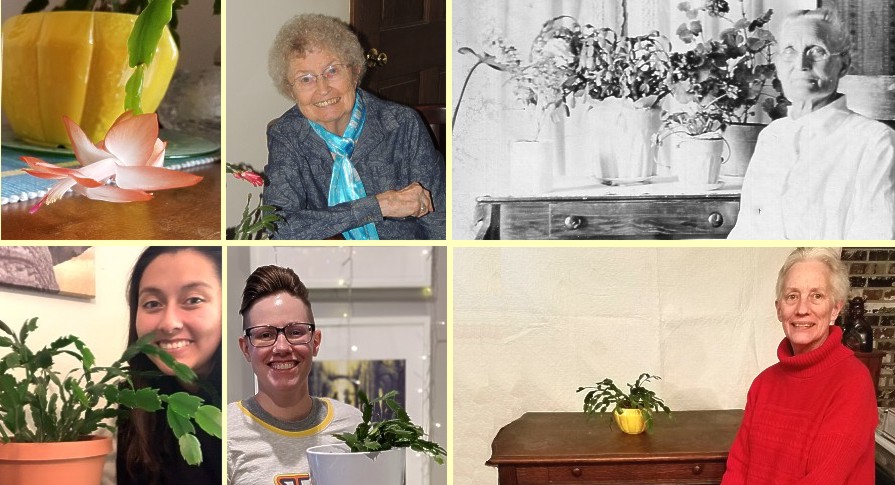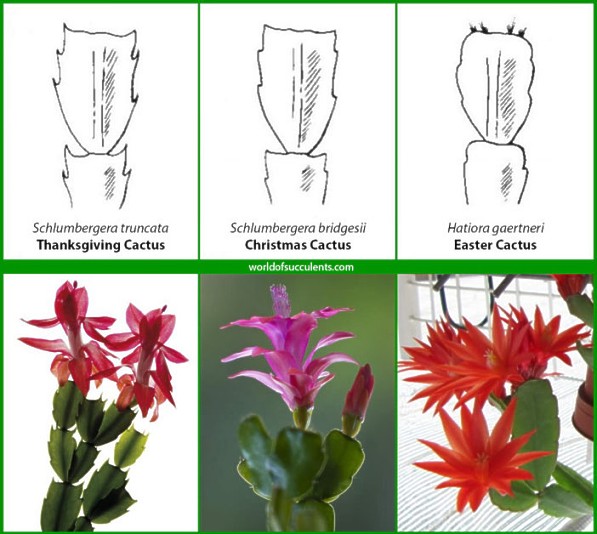Kansas Snapshots by Gloria Freeland - December 4, 2020
A cactus for Christmas?
With Christmas on the horizon, we will be frequently serenaded with songs and seeing images that make us think of cold weather and
snow-covered evergreens. But images of cacti? Well, not so much!
But add "Christmas" in front of the word "cactus" and it seems to fit. My thoughts immediately go to Mom, who always had a Christmas
cactus in her home. Kept near a south window, it rewarded her many times over with beautiful pinkish blossoms.
When Mom died, I arranged for a florist to put it in a foil wrapper with a bow for the service. After, niece Larisa "adopted" it
and now has it in her Bozeman, Montana apartment.
The memories that always come to mind when I'm watering my Christmas cactus is Grandma. I never water it with a watering can. I
always walk it to the sink, turn on the faucet for 30 seconds and let it drain in the sink, preferably before lunch so I can take
it back to its place when lunch is done. It's also always watered on Sunday. I'm pretty sure that's when she would water it. Such
an ingrained memory of the Christmas cactus and grandma. That's my favorite part of my Christmas cactus. ...
A recent Instagram message from friend Susan made me aware that there are actually three varieties of the succulents - Christmas,
Thanksgiving and Easter. Susan had posted a photo of her Thanksgiving cactus and a drawing and photos that illustrated the blooms
and different shapes of the "leaf" segments of the three. Since each segment is connected to the next, they are not leaves, but
flattened stems.
My curiosity piqued, I knew this would require further research. My first discovery was that English explorer Allan Cunningham was
the first botanist to collect and document Christmas cacti during an expedition to their native Brazil in the early 1800s.
A December 2016 Kansas State University Horticulture Newsletter described the plants:
Christmas Cactus (Schlumbergera bridgesii), [Easter Cactus (Schlumbergera gaertneri)] and Thanksgiving Cactus (Schlumbergera
truncata) are epiphytes native to the jungles of South America. Epiphytic plants grow on other plants and use them for support but
not for nutrients. Though these cacti are different species, they will hybridize and produce varying stem shapes. Christmas cactus
normally has smooth stem segments, and Thanksgiving Cactus has hook-like appendages on each segment.
Another source, gardeningknowhow.com, said the three holiday cacti are named for the time of year the blooms appear. Although the
flowers are typically red, other colors include pink, yellow, white, orange, purple and salmon.
I've had a Thanksgiving cactus in our home for many years, but I haven't had as much luck with blooms as Mom did. So I was excited
to see a single bud this fall blossom into a salmon-pink flower a few days before Thanksgiving.
I hadn't been taking proper care of it to encourage blooming. According to the newsletter, I should have moved it to an unused room
or covered it with a dark cloth or cardboard box to ensure it received at least 25 nights of uninterrupted darkness. The plant also
requires temperatures of at least 50 degrees F, doesn't like direct sun and needs proper drainage.
I must confess that all my plants experience some measure of neglect, and so I had wondered whether repotting my cactus would be
good for it. But birdsand blooms.com said these cacti grow slowly and bloom best when they are root-bound. Repotting should only be
done when it's not blooming.
The newsletter explained propagating was easy. You break off a stem with two to five segments, set the stem aside until the broken
end forms a callus, then plant it in a pot filled with a mixture of sand and potting soil.
A fun fact was that holiday cacti can live for decades. One Montana family has had the same Christmas cactus for more than 145 years!
A love for these succulents has been evident in my family as well. I have a photo of my great-grandmother Maria next to a large one.
Her daughter Hulda and granddaughters Mom and Edith also had them. My daughter Mariya and Larisa are the fifth generation to have
them.
Husband Art found a reference to a similar plant - a Christmas aloe - in his great-great grandfather's chronicle of his life.
Written about 1843, Ernst shared a story about his father Christian, who lived in Furstenau, a crossroads village now in southwestern
Poland:
Although he was a Protestant, he was on good terms with the very old Catholic priest Schardekk. On one ... Sunday morning, my father
and his friend Gottfried Schoenborn came to the second service in the Catholic church, there not being an evangelical church in
Furstenau. ... But the Protestants, going into the church! These heretics; what pigs! Having two Protestants in church was too much,
and the people stood and cast open the church doors and the quarrel was so loud that it was widely heard. ... Schardekk sent a
reconciliation Aloe plant to my father, which in 50 years bloomed only once, but it will bloom this year and it should be a splendid
bloom.
Since Christmas time is the principal gift-giving time of year, maybe images of a cactus should be mixed with those of snow-covered
fields, decorated trees and beautifully wrapped presents. During my searching, I encountered a 2017 article called "Nature�s Gift"
from the Manchester (England) Museum's website. The following excerpt says it well!
Thinking about Christmas gifts? How about a treat from nature? Forget poinsettias and potted Christmas trees - what about a seasonal
houseplant that's made of much tougher stuff - the beautiful and exotic Christmas Cactus! ... The Christmas cactus ... has been
cherished all over the world for its beauty and sentimental values. Let's appreciate this, and other gifts from nature over the
festive season.

